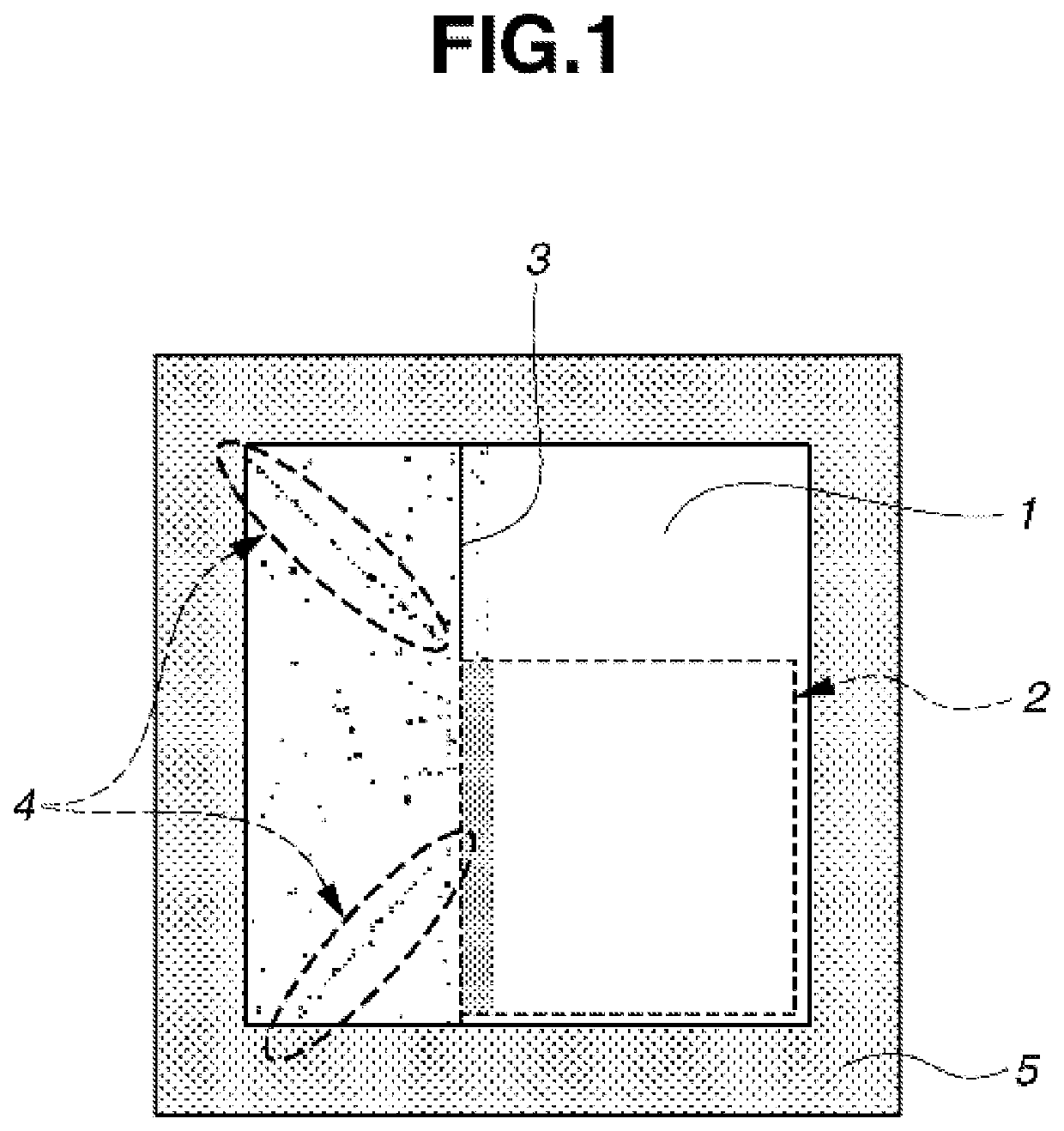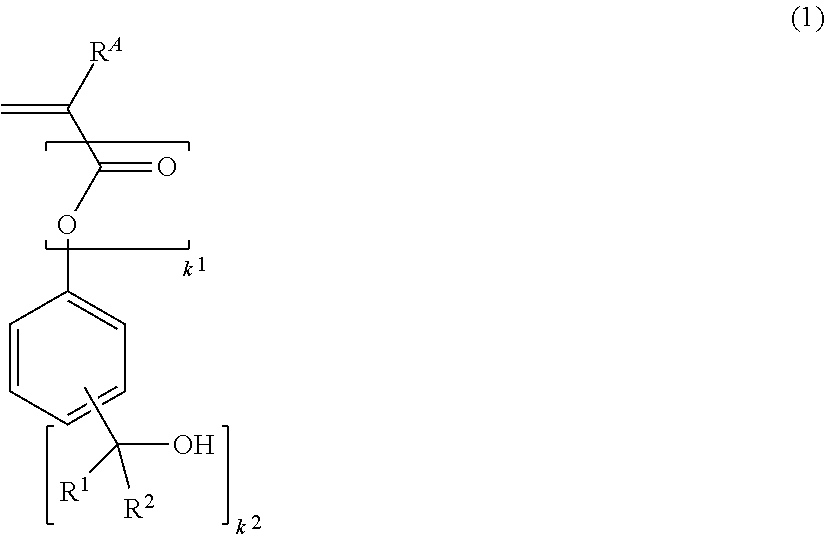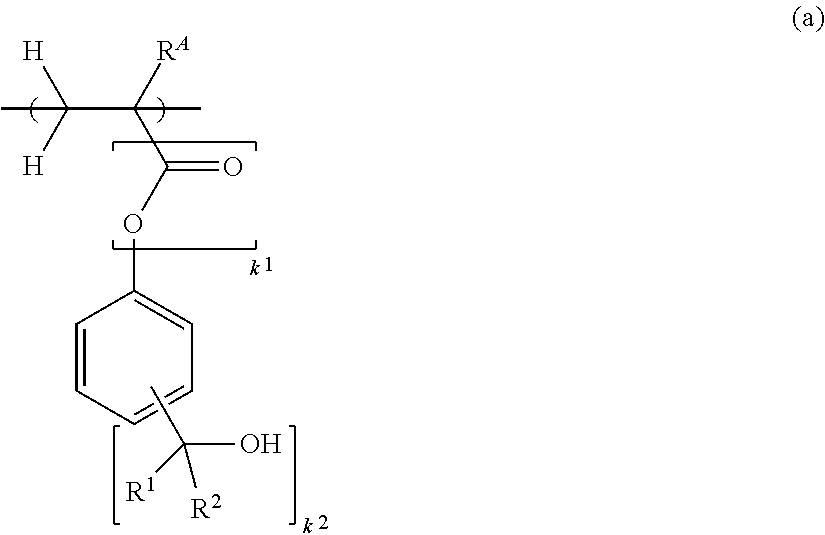Monomer, polymer, negative resist composition, photomask blank, and resist pattern forming process
- Summary
- Abstract
- Description
- Claims
- Application Information
AI Technical Summary
Benefits of technology
Problems solved by technology
Method used
Image
Examples
example 1-1
[0143]Synthesis of Monomer 1
[0144]In a reactor, 440 g of dimethyl 3-bromoisophthalate (1-1) was dissolved in 3.5 kg of tetrahydrofuran (THF). Then 3.6 kg of a THF solution of 3 mol / L methylmagnesium chloride was added dropwise over 2 hours to the reactor in a water bath at 50° C. Under ice cooling, 5 kg of saturated ammonium chloride aqueous solution was added to the reaction solution. The organic layer was taken out and the water layer was extracted with 3 kg of ethyl acetate, followed by concentration under reduced pressure. Toluene was added to the concentrate, which was concentrated again. The precipitated solid was washed with hexane and dried under reduced pressure, obtaining 264 g of the desired compound, 3,5-bis(2-hydroxy-2-propyl)bromobenzene (1-2) as white solid (yield 60%).
[0145]Subsequently, 152 g of 3,5-bis(2-hydroxy-2-propyl)bromobenzene (1-2) and 94.6 g of imidazole were dissolved in 304 g of dimethylformamide (DMF). Under ice cooling, 168 g of triethylsilyl chloride ...
example 1-2
[0146]Synthesis of Monomer 2
[0147]In a reactor, 270 g of dimethyl 3-acetoxyisophthalate (2-1) was dissolved in 3.5 kg of THF. Then 3.6 kg of a THF solution of 3 mol / L methylmagnesium chloride was added dropwise over 2 hours to the reactor in a water bath at 50° C. Under ice cooling, 5 kg of saturated ammonium chloride aqueous solution was added to the reaction solution. The organic layer was taken out and the water layer was extracted with 3 kg of ethyl acetate, followed by concentration under reduced pressure. Toluene was added to the concentrate, which was concentrated again. The precipitated solid was washed with hexane and dried under reduced pressure, obtaining 187 g of the desired compound, 3,5-bis(2-hydroxy-2-propyl)phenol (2-2) as white solid (yield 73%).
[0148]Subsequently, 515 g of 3,5-bis(2-hydroxy-2-propyl)phenol (2-2) was mixed with 417 g of triethylamine and 1,500 g of THF. 282 g of methacryloyl chloride was added dropwise to the mixture over 1 hour, followed by stirrin...
example 2-1
[0149]Synthesis of Polymer 1
[0150]A 500-mL dropping funnel under nitrogen blanket was charged with 62.5 g of a 50 wt % PGMEA solution of 4-hydroxystyrene, 8.51 g of acenaphthylene, 49.3 g of 3,5-bis(2-hydroxy-2-propyl)styrene, 11.0 g of triphenylsulfonium 1,1,3,3,3-pentafluoro-2-methacryloyloxypropane-1-sulfonate, 10.3 g of dimethyl2,2′-azobis(2-methylpropionate) (V601 by Wako Pure Chemical Industries, Ltd.), and 156 g of γ-butyrolactone and 24 g of PGMEA as solvent to form a solution A. A 1000-mL flask under nitrogen blanket was charged with 78 g of γ-butyrolactone, which was heated at 80° C. While the temperature was maintained, solution A was added dropwise to the flask over 4 hours. At the end of dropwise addition, the solution was continuously stirred for 18 hours while the temperature of 80° C. was maintained during polymerization. The polymerization solution was cooled to room temperature and added dropwise to 3,000 g of diisopropyl ether, whereupon a solid precipitated. The ...
PUM
| Property | Measurement | Unit |
|---|---|---|
| Fraction | aaaaa | aaaaa |
| Fraction | aaaaa | aaaaa |
| Fraction | aaaaa | aaaaa |
Abstract
Description
Claims
Application Information
 Login to View More
Login to View More - R&D
- Intellectual Property
- Life Sciences
- Materials
- Tech Scout
- Unparalleled Data Quality
- Higher Quality Content
- 60% Fewer Hallucinations
Browse by: Latest US Patents, China's latest patents, Technical Efficacy Thesaurus, Application Domain, Technology Topic, Popular Technical Reports.
© 2025 PatSnap. All rights reserved.Legal|Privacy policy|Modern Slavery Act Transparency Statement|Sitemap|About US| Contact US: help@patsnap.com



